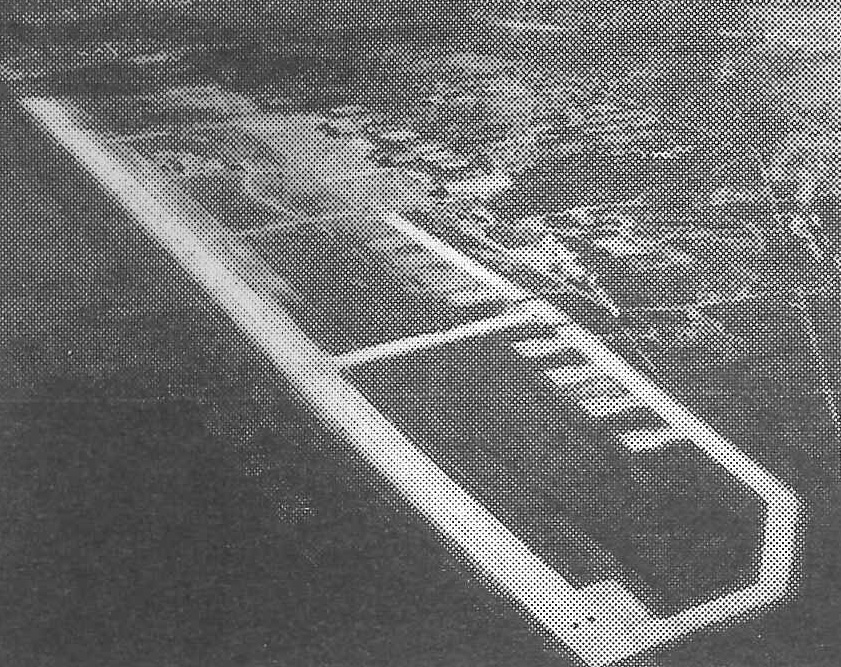| 朝鮮戦争の勃発(昭和25年6月)により極東空軍爆撃司令部の連隊が駐留し、横田基地は、朝鮮戦争における国連軍の主要基地となった。この時期から軍用機のジェット化が進んだ。昭和30年には、接収地のほかに基地拡張計画がなされ、滑走路はますます瑞穂町に延びていった。昭和31年から40年にかけて、滑走路の北端より国道16号(現都道166号線)の間を買収し、3,350mの滑走路を完備した大規模基地となった。 | By the outbreak of the Korean War (June, 1950), part of the US Far East Air Force bomber headquarters was stationed here, and the Yokota Air Base became the main base of the United Nations forces in the Korean War. From this period, military aircraft phased over into jet versions. In 1955, a base expansion plan pushed out the area of already-requisitioned land, so that the runway increasingly encroached into Mizuho. Through 1956-1965, with the acquisition of the land between the northern end of the runway and the National Route 16 (present Prefectural Route 166), it became a large-scale air base fully equipped with a runway of 3,350 m. |
| その後、戦闘機部隊は沖縄に移駐し、戦闘機基地としての性格は薄れたが、ベトナム戦争の激化に伴い輸送中継基地としての重要性を増した。また、ミドルマーカー(昼間電波誘導信号所)が設置され、C5A等による輸送活動が活発に行われ、これに合わせて騒音等の被害が激化した。(昭和46年~47年) | Subsequently, the fighter units were transferred to Okinawa, and its role as a fighter base reduced, while becoming more important as a transshipment base due to the intensification of the Vietnam War. In addition, a middle marker (daytime radio navigational signal station) was installed, and intense transport activities by C5A and similar heavy aircraft were undertaken, which only intensified the impact of noise, vibration, etc. (From 1971 to 1972) |
| 昭和48年1月、日米安全保障協議委員会で関東平野にある米軍施設を横田飛行場に整理統合する計画、いわゆる「関東計画」が決定された。翌年11月には、在日陸海空三軍の調整等を主任務とする在日米軍司令部が移転された。 | In January 1973, the US-Japan Security Consultative Committee decided upon the so-called "Kanto Plan", which was to consolidate the US military facilities in the Kanto Plain to Yokota Air Base. In November the following year, the USFJ headquarters, whose main mission was the coordination of the three arms of army, navy and air force in Japan, moved in. |
| 昭和50年には、C-130ハーキュリーズを配した第345戦術空輸部隊が移駐し、漸減していた航空機の離着陸も再び増加した。このような状況の中で昭和51年4月及び昭和52年11月の2回にわたり、米軍機の夜間飛行の禁止、騒音被害に対する損害賠償を求める公害訴訟(第1次、第2次)が提起された。 | In 1975, the 345th Tactical Airlift Squadron, equipped with C-130 Hercules, transferred to the base, and so the number of aircraft takeoffs and landings, which had been gradually reducing, now increased again. Under such situations, two pollution lawsuits (the first and the second) were filed (April 1976 and in November 1977) calling for the cessation of US military night flights and for compensation for damage caused by noise pollution. |
| 昭和62年7月、第1次、第2次訴訟の控訴審判決において東京高裁は、夜間飛行差し止め請求は却下したが、第1審判決を上回る慰謝料の支払いを認めた。その後、新たに平成6年12月には横田基地飛行差止訴訟団、平成8年4月には新横田基地公害訴訟団、平成24年12月には第9次横田基地公害訴訟原告団、平成25年3月には第2次新横田基地公害訴訟原告団がそれぞれ東京地裁へ提訴している。 | In July 1987, in its appeal court ruling the Tokyo High Court rejected the night flight suspension request in both suits, but in the second suit did award a higher compensation payment than had been granted in the first appeal court judgment. Since then, multiple new lawsuits were filed with the Tokyo District Court by a litigation team seeking a flight suspension injunction against Yokota Air Base in December 1994, a new Yokota Air Base pollution litigation team in April 1996, the 9th Yokota Air Base pollution lawsuit plaintiff group in December, 2012, and the 2nd new Yokota Air Base pollution lawsuit plaintiffs in March, 2013. |
| 昭和58年1月以降、米海軍機による夜間着陸訓練(NLP)が数次にわたり行われ、これに対し横田基地周辺市町基地対策連絡会(5市1町)で、平成8年11月以降は、横田基地に関する東京都と周辺市町連絡協議会にて、関係機関に対し中止要請を繰り返し行い、抗議をするとともに日常の被害状況を訴えている。なお、NLPについては、平成13年度以降、横田基地では実施されておらず、平成22年度以降は硫黄島での実施が不可能な際の代替飛行場に指定されることもなくなっている。 | From January 1983, US naval aircraft were involved in multiple night landing practice (NLP) exercises. These prompted repeated requests to the relevant agencies for the suspension for these flights, first from the Liaison Council of Municipalities Surrounding Yokota Air Base Concerning Yokota Air Base (five cities and one town) and, after November 1996, from the Liaison Council of Tokyo Metropolitan Government and Municipalities Surrounding Yokota Air Base Concerning Yokota Air Base. In addition, complaints were lodged for damages incurred on those exercise days. In addition, it should be noted that the agreed Night Landing Practice (NLP) had not been implemented at the Yokota Air Base from 2001 onward, and after 2010 the base was also no longer designated as an alternative airfield when NLP was not possible at Iwo Jima. |
| 平成13年3月から平成14年7月にかけて、日本政府の負担により滑走路の全面改修が行われた。この間、基地北側は平成13年10月から平成14年2月半ば、南側は平成14年2月半ばから平成14年6月末まで滑走路を閉鎖した。 | Through March 2001 to July 2002, the entire surface refurbishment of the runway was carried out at the expense of the Japanese government. During this period, the runway at the north side of the base was closed between October 2001 and mid-February 2002, and the south side between mid-February and the end of June 2002. |
| 平成13年9月11日の米国における同時多発テロ以降、横田基地では厳重な警戒態勢が敷かれ、平成14年5月より同年11月まで、ほぼ毎月の割合で基地での訓練が行われた。ジャイアントボイス(拡声器)による大音響のサイレン音等により、基地周辺の住民に迷惑と不安を与えるなど、大きな問題となった。 | Following the terrorist attacks on September 11, 2001 in the United States, strict precautionary steps are in place at Yokota Air Base, and training was held almost monthly at the base from May to November, 2002. The loud booming siren of Giant Voice (a loudspeaker), etc., created gave anxiety and upset among the residents around the base, and became a major problem. |
| 平成15年9月には、ヘリパッド(ヘリコプターの訓練用着陸地点)が、瑞穂町側から南側へ約1.7㎞の位置に新設され、ヘリコプターによる訓練は基本的には新しい場所で実施されることとなった。また、平成15年10月までにC-9A航空医療搬送機4機が横田基地から引退し、第374航空医療搬送中隊は解散した。平成19年6月にはリアジェット機C-21Aからターボプロップ機C-12Jに切り替わり、横田基地常駐機はすべてプロペラ機となった。 | In September 2003, new helipads for helicopter landing training were built some 1.7 km south of Mizuho, and thereafter any training by helicopter was primarily carried out at the new location. In addition, four of the C-9A Nightingale, Aeromedical Evacuation aircraft retired from the Yokota Air Base by October 2003, and the 374th Aeromedical Evacuation Squadron was disbanded. In June 2007, the C-21A rear-engined jets were replaced by C-12J turboprops, and so all the resident aircraft became propeller-type at the Yokota Air Base. |
| 平成16年以降、横田基地所属UH-1Nの9回に渡る予防着陸やペットボトル落下事故をはじめ、C-130からのヘルメットやアンテナ落下事故、基地内においては油漏れ事故等が発生しており、その都度、横田基地に関する東京都と周辺市町連絡協議会において地域住民の安全のため、事故再発防止の要請活動を行ってきた。 | Since 2004, there have been a number of incidences involving aircraft of the Yokota Air Base, including more than nine instances of precautionary landings and falls of plastic bottles by UH-1N's, dropped helmets and aerials from C-130, and oil leakage in the area within the base. In each case, through the Liaison Council of Tokyo Metropolitan Government and Municipalities Surrounding Yokota Air Base Concerning Yokota Air Base, we called for measures to prevent the recurrence of such accidents threatening local residents’ safety. |
| 平成23年以降、サムライサージ等、輸送機の編隊飛行や基地内へのパラシュート降下訓練、物資投下訓練がしばしば行われるようになり、基地所属部隊だけでなく沖縄等の米軍も参加していることから、事故への不安や基地機能の強化を懸念する声が上がっている。 | From 2011 onward, training practices such as Samurai Surge (e.g., transport aircraft formation flights, parachute drop training within the base, and materiel-drop training) are frequent occurrences. The fact that these exercises involve not only the base troops, but also US forces from Okinawa, only heightens residents’ anxiety about accidents and a concern that the base’s role is being unstoppably expanded. |
